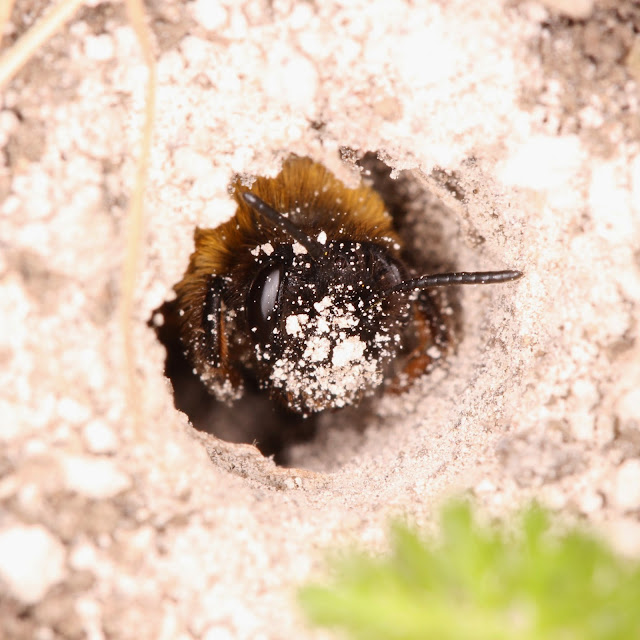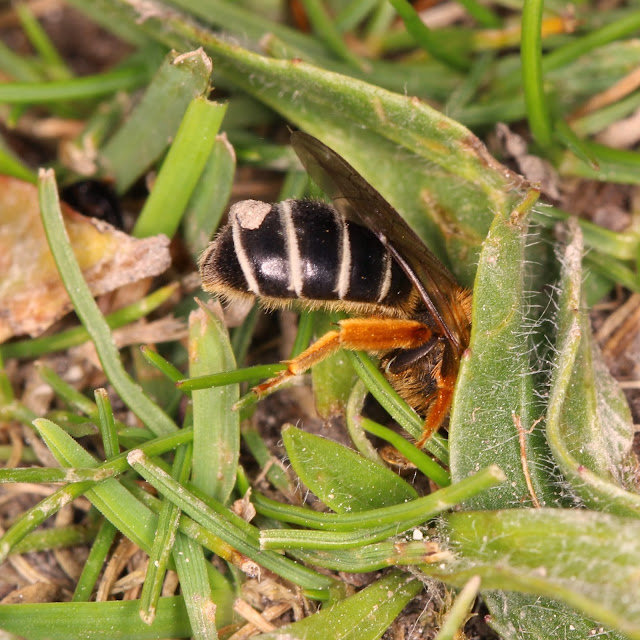but there were very few males.
This female made the mistake of trying the wrong nest hole.
Here is the rightful owner, her face covered in chalk.
I also found my first female Andrena cineraria (Ashy mining bee).
And this is the male.
And my first Andrena haemorrhoa (Orange-tailed mining bee).
This one shows how she carries the pollen.
Then there was this bee which I think is a female Halictus rubicundus (Orange-legged furrow bee).
There were far more Nomada goodeniana cuckoo bees than last time. This one is sniffing out a nest hole with her antennae. She stayed like this for more than a minute before deciding not to enter. Usually they scan for no more than a second before moving on.
This one beat a rapid retreat from the nest hole, perhaps having met the owner halfway down.
I also found another Nomada bee which I think is N. signata. It is said to be a cleptoparasite of Andrena fulva (tawny mining bee) but I haven't found any of those yet. Maybe it targets other Andrena bees as well.
This tiny bee is about half the size of the others and is another cuckoo, a Sphecodes bee (Blood bee) - there are 16 British species which are difficult to tell apart so I won't even try. They parasitise Andrena and Halictid bees. It occurs to me that, as well as cheating the host bees, cuckoo bees cheat the flowers because they drink the nectar but don't help with pollination - they don't collect pollen and are smooth rather than hairy so it won't stick to them. I suppose it works for them and they can get away with it.
Also in evidence was a bee-fly (Bombylius major), another parasite of solitary bees.
All the photos above were taken with a macro lens and ring flash. The photography is a challenge as it is low down (I get chalk all over my knees) but mainly because the bees move quickly. They hunt around for the right hole and then dive in. I also tried a 300mm telephoto lens in natural light and it gives reasonably good results, certainly good enough for identification in these Andrena nigroaenea and A. cineraria pictures. For most things though I'll stick to the macro lens.
I guess the reason the bees don't hang around is that like most flights they are their most vulnerable when coming in to land, although in their case the hazard is predators, mainly birds. This carrion crow was running around catching bees. Although it was some way off you can make out the bees in its beak.
Quite an amazing variety of bees living side by side. If you can improve on any of the identifications please leave a message. To help me with identification I have been using BWARS, Steven Falk's astonishing Flickr site and Ed Phillips' image gallery.




























Wonderful photos. I especially like the Ashy mining bee. Do you ever contribute photos to the BWARs magazine?
ReplyDeleteI think the ashy mining bee is one of my favourites. I'm new to these bees and I'm not even a member of BWARS - I've only just sent off my form. Maybe I can contribute once I have joined.
DeleteI see. Your photos reminded me of some I've seen on the cover of the magazine, they usually have a couple of beautiful full colour photos.
DeleteThis is super interesting Chris! I'll have to try and remember it all. And I thought birds were hard!
ReplyDelete